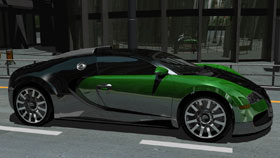NVIDIA Shows Interactive Ray Tracing on GPUs
We just received some breaking news out of SIGGRAPH 2008 that we thought many of you would be very interested in. If you recall, one of the capabilities Intel is touting in regard to their upcoming Larrabee architecture is the ability to perform real-time ray tracing. In the graphics space, ray tracing is a technique used to generate an image by tracing the rays or paths of light as they bounce through and around the objects in a scene. When done right, ray tracing can produce photorealistic imagery because shadows are cast correctly, water and other materials show proper reflections with correct coloring, and lighting in general just looks more realistic. The problem with ray tracing is that the algorithms necessary for producing photorealistic imagery are very complex and require much more compute power than is available in today's PCs, if the imagery is to be rendered in real-time, at a high enough frame rate to produce fluid motion, i.e. for gaming.
To date, a number of real time ray tracing projects have been shown on the PC. Intel's Daniel Pohl, for example, has showcased customized versions of Quake 3 and Quake 4 running on Intel hardware that use ray tracing with impressive results and ATI has recently shown ray tracing demos running on Radeon HD 4800 series hardware at their Cinema 2.0 event. But today, it's NVIDIA's turn.
During SIGGRAPH 2008 in Los Angeles NVIDIA is demonstrating a fully interactive GPU-based ray tracer. The demo is based purely on NVIDIA GPU technology, and according to NVIDIA the ray tracer shows linear scaling while rendering a complex, two-million polygon, anti-aliased automotive styling application. Screenshots from the actual demo are shown here.
At three bounces, performance is demonstrated at up to 30 frames per second (fps) at HD resolutions of 1920x1080 for an image-based lighting paint shader, ray traced shadows, reflections and refractions running on four next-generation Quadro GPUs in an NVIDIA Quadro Plex 2100 D4 Visual Computing System (VCS). Some of these screenshots, however, were taken with the resolution increased all the way up to 2560x1600. Frame rates at that resolution weren't available though.
If we can speculate for a bit here, let's assume that the next-gen Quadros NVIDIA is using for the demo are based on the company's GTX 200 series GPU architecture. That means, potentially, a 3-way GeForce GTX 280 SLI configuration may offer approximately 75% of the performance of Quadro Plex 2100 D4 VCS being used in the demo. If history is an indicator, sometime within the next 18 months or so, NVIDIA is likely to double the performance of their current GPUs. So, by sometime next year or maybe in the early part of 2010, we'll likely have the necessary horsepower in a high-end gaming PC to handle some level of real-time ray tracing with adequate performance for fluid motion. Over the next few months to a year, expect to hear much more on this front.
To date, a number of real time ray tracing projects have been shown on the PC. Intel's Daniel Pohl, for example, has showcased customized versions of Quake 3 and Quake 4 running on Intel hardware that use ray tracing with impressive results and ATI has recently shown ray tracing demos running on Radeon HD 4800 series hardware at their Cinema 2.0 event. But today, it's NVIDIA's turn.


NVIDIA's GPU RayTracing Demo In Action
During SIGGRAPH 2008 in Los Angeles NVIDIA is demonstrating a fully interactive GPU-based ray tracer. The demo is based purely on NVIDIA GPU technology, and according to NVIDIA the ray tracer shows linear scaling while rendering a complex, two-million polygon, anti-aliased automotive styling application. Screenshots from the actual demo are shown here.


NVIDIA GPU Ray Tracing at 2560x1600
At three bounces, performance is demonstrated at up to 30 frames per second (fps) at HD resolutions of 1920x1080 for an image-based lighting paint shader, ray traced shadows, reflections and refractions running on four next-generation Quadro GPUs in an NVIDIA Quadro Plex 2100 D4 Visual Computing System (VCS). Some of these screenshots, however, were taken with the resolution increased all the way up to 2560x1600. Frame rates at that resolution weren't available though.
If we can speculate for a bit here, let's assume that the next-gen Quadros NVIDIA is using for the demo are based on the company's GTX 200 series GPU architecture. That means, potentially, a 3-way GeForce GTX 280 SLI configuration may offer approximately 75% of the performance of Quadro Plex 2100 D4 VCS being used in the demo. If history is an indicator, sometime within the next 18 months or so, NVIDIA is likely to double the performance of their current GPUs. So, by sometime next year or maybe in the early part of 2010, we'll likely have the necessary horsepower in a high-end gaming PC to handle some level of real-time ray tracing with adequate performance for fluid motion. Over the next few months to a year, expect to hear much more on this front.

